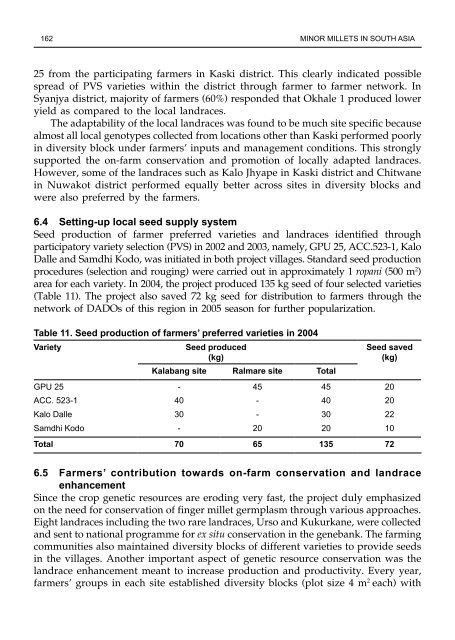Minor millets in South Asia: learnings from IFAD-NUS project in India ...
Minor millets in South Asia: learnings from IFAD-NUS project in India ...
Minor millets in South Asia: learnings from IFAD-NUS project in India ...
You also want an ePaper? Increase the reach of your titles
YUMPU automatically turns print PDFs into web optimized ePapers that Google loves.
162 m<strong>in</strong>or <strong>millets</strong> <strong>in</strong> south asia<br />
25 <strong>from</strong> the participat<strong>in</strong>g farmers <strong>in</strong> Kaski district. This clearly <strong>in</strong>dicated possible<br />
spread of PVS varieties with<strong>in</strong> the district through farmer to farmer network. In<br />
Syanjya district, majority of farmers (60%) responded that Okhale 1 produced lower<br />
yield as compared to the local landraces.<br />
The adaptability of the local landraces was found to be much site specific because<br />
almost all local genotypes collected <strong>from</strong> locations other than Kaski performed poorly<br />
<strong>in</strong> diversity block under farmers’ <strong>in</strong>puts and management conditions. This strongly<br />
supported the on-farm conservation and promotion of locally adapted landraces.<br />
However, some of the landraces such as Kalo Jhyape <strong>in</strong> Kaski district and Chitwane<br />
<strong>in</strong> Nuwakot district performed equally better across sites <strong>in</strong> diversity blocks and<br />
were also preferred by the farmers.<br />
6.4 Sett<strong>in</strong>g-up local seed supply system<br />
Seed production of farmer preferred varieties and landraces identified through<br />
participatory variety selection (PVS) <strong>in</strong> 2002 and 2003, namely, GPU 25, ACC.523-1, Kalo<br />
Dalle and Samdhi Kodo, was <strong>in</strong>itiated <strong>in</strong> both <strong>project</strong> villages. Standard seed production<br />
procedures (selection and roug<strong>in</strong>g) were carried out <strong>in</strong> approximately 1 ropani (500 m 2 )<br />
area for each variety. In 2004, the <strong>project</strong> produced 135 kg seed of four selected varieties<br />
(Table 11). The <strong>project</strong> also saved 72 kg seed for distribution to farmers through the<br />
network of DADOs of this region <strong>in</strong> 2005 season for further popularization.<br />
Table 11. Seed production of farmers’ preferred varieties <strong>in</strong> 2004<br />
Variety Seed produced<br />
(kg)<br />
Kalabang site Ralmare site Total<br />
Seed saved<br />
(kg)<br />
gpu 25 - 45 45 20<br />
aCC. 523-1 40 - 40 20<br />
Kalo dalle 30 - 30 22<br />
samdhi Kodo - 20 20 10<br />
Total 70 65 135 72<br />
6.5 Farmers’ contribution towards on-farm conservation and landrace<br />
enhancement<br />
S<strong>in</strong>ce the crop genetic resources are erod<strong>in</strong>g very fast, the <strong>project</strong> duly emphasized<br />
on the need for conservation of f<strong>in</strong>ger millet germplasm through various approaches.<br />
Eight landraces <strong>in</strong>clud<strong>in</strong>g the two rare landraces, Urso and Kukurkane, were collected<br />
and sent to national programme for ex situ conservation <strong>in</strong> the genebank. The farm<strong>in</strong>g<br />
communities also ma<strong>in</strong>ta<strong>in</strong>ed diversity blocks of different varieties to provide seeds<br />
<strong>in</strong> the villages. Another important aspect of genetic resource conservation was the<br />
landrace enhancement meant to <strong>in</strong>crease production and productivity. Every year,<br />
farmers’ groups <strong>in</strong> each site established diversity blocks (plot size 4 m 2 each) with

















